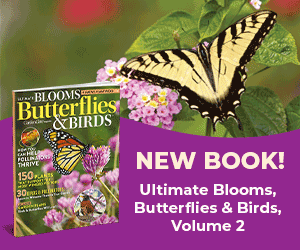
Grow flowering shrubs that look great throughout the year
Flowers are usually the first thing someone notices about a plant. After all, you can’t miss the bold orange blooms of a daylily (Hemerocallis hybrid) or a giant sunflower (Helianthus annuus), but once those flowers fade, there’s not a whole lot to attract attention. So, if your borders are looking a bit blasé, some of the best plants you can invest in are a few multiseason shrubs. They provide structure for borders filled with annuals and perennials and grow happily in the garden for years. Even better, they have more than one season of interest, so they keep the show going even after the flowers fade.
Foliage adds interest to the garden
Foliage is one of the ways shrubs provide nonstop border color. You’ll find some with variegated leaves or that change color seasonally. Flowering shrubs often produce berries or seedheads that are interesting to gardeners and provide a meal for hungry birds. Others, such as the oakleaf hydrangea above, have flowers that dry in place, lasting well into winter. Once the foliage drops, its peeling bark brings a whole new dimension to late-season gardens. And this impressive plant is just the beginning.
Meet our top picks for flowering shrubs with multiseason interest
We've picked 8 of our favorite garden shrubs that not only offer blooms, but may also feature also unique foliage, bark or other features that add interest to the garden throughout the seasons. Find a few to add to your garden!

Amber Jubilee™ ninebark
Physocarpus opulifolius
You’ll find a lot of ninebark varieties at the garden center, but Amber Jubilee is one of the most colorful and has good resistance to powdery mildew. This tough native shrub’s pink buds open to white flowers in spring. Bees, moths and lots of other pollinators often visit. New growth is orange, red and gold with green veins that mature to solid green for summer. In autumn, leaves turn to shades of red and purple, and once they fall, the exfoliating bark of mature stems add interest to the winter garden.
Pruning tip
This flowering shrub has an upright habit and isn’t as likely to sucker as the species. You may want to thin established plants every few years by cutting a third of the oldest stems back to the ground. This ensures a full habit and plenty of colorful new growth and flowers.
Type: Shrub
Multiseason appeal: Pink spring buds that open to white; new orange, red and gold foliage; red and purple fall foliage; exfoliating bark
Light: Full sun
Soil: Average, well-drained
Size: 5 to 7 ft. tall, 4 to 6 ft. wide
Cold hardy: USDA zones 2 to 7
Source: White Flower Farm, 800-503-9624

Black Lace® elderberry
Sambucus nigra f. porphyrophylla
The finely cut inky foliage of Black Lace elderberry looks like a Japanese maple, but the plant tolerates cold and full sun better. Its large pink flower clusters can grow to 6 inches or more in diameter and have a light lemony scent. Bees and butterflies enjoy the blooms’ nectar, and birds devour the small purple-black berries that follow in late summer. You can eat them too, but they’ll need to be cooked first: Raw berries are poisonous.
Black Lace has the best foliage color in full sun, where that beautiful purple-black hue holds from spring to frost. It makes a great focal point in mixed borders, or use it to screen a view from the patio. New growth is green but darkens with age. However, extra-hot temperatures can cause even mature foliage to green up a bit.
Pruning tip
Pruning is easy but not needed very often. Just remove dead stems in early spring or shape plants after flowers fade. You can even cut up to a third of the biggest stems to the ground in early spring to encourage vigorous new stems.
Good to know
To increase the quantity of berries, plant another cultivar nearby. Black Beauty®, Instant Karma® or Laced Up® all bloom about the same time, ensuring pollination.
Type Shrub
Multiseason appeal Dome-shaped pink early summer flowers; small late summer purple-black berries; new green foliage that matures to purple-black
Light Full sun
Soil Moist, well-drained
Size 6 to 8 ft. tall and wide
Cold hardy USDA zones 5 to 7
Source Great Garden Plants, 877-447-4769

Gatsby Gal® oakleaf hydrangea
Hydrangea quercifolia
Native to the southeastern United States, oakleaf hydrangea can handle the heat and humidity of summer but needs some shelter from cold winter winds in USDA zone 5 and colder. While the species can grow as tall as 12 feet, Gatsby Gal is more compact, at just 5 to 6 feet tall. White early summer flowers age to pink, fade to tan in autumn and hold on through winter. Oak-shaped leaves are green in spring and summer but age to wine red in fall. After the leaves drop, the peeling bark takes center stage.
Type Shrub
Multiseason appeal Pyramidal white flowers in early summer that age to pale pink, then brown; mahogany-red fall foliage; cinnamon-colored exfoliating bark
Light Full sun to part shade
Soil Moist, well-drained
Size 5 to 6 ft. tall and wide
Cold hardy USDA zones 5 to 9
Source Garden Crossings, 616-875-6355
You Might Also Like:
Pink Hydrangea Garden Tour in Minnesota
Four-season Hydrangea Garden Border Plan
Garden Design Book Bundle

Cranberry cotoneaster
Cotoneaster apiculatus
Stiff, arching stems and a low spreading habit make cranberry cotoneaster a great addition near the front of the border. And if you need a tough, salt-tolerant shrub to grow along the parking strip or driveway, this plant can do the job. In addition, it’s deer and rabbit resistant so you won’t miss out if these pests often mow down other plants in your garden.
Small pink flowers open in late spring among the glossy dark green leaves. Bright red berries follow in late summer and are a treat for the birds but not people. In fall, cranberry cotoneaster’s foliage turns bright red before falling, and in winter its arching stems and remaining berries provide interest and structure.
Plants are slow growing but form a dense habit and root where stems touch the ground, so you can use it for erosion control or as a ground cover. Cranberry cotoneaster doesn’t do well in hot, humid regions and may struggle in parts of USDA zone 7 and warmer. Most of the time you’ll find the species for sale, but the hybrid ‘Tom Thumb’ is a bit smaller, growing 1 to 3 feet tall and 5 feet wide.
Type Shrub
Multiseason appeal: Small pink late spring blooms; bright red late summer berries; red fall foliage
Light: Full sun to part shade
Soil: Moist, well-drained
Size: 3 ft. tall, 3 to 6 ft. wide
Cold hardy: USDA zones 4 to 7
Source: Local garden centers

Variegated Japanese pieris
Pieris japonica ‘Variegata’
Cascading white urn-shaped spring flowers that last for several weeks and showy evergreen foliage make variegated Japanese pieris a head-turning shrub. Its green leaves are edged with creamy white that’s tinted pink when new growth emerges. Beadlike muted red flower buds form in late summer but wait until the following spring to open—and they’re a mason bee favorite.
This is a slow-growing shrub with an upright spreading habit that you can use mid- to back of the border or as a hedge. Plants do best in organically rich, slightly acid soil. Variegated Japanese pieris grows well in full sun or part shade. Pruning isn’t usually needed, and you don’t have to deadhead variegated Japanese pieris, but removing spent blooms will tidy up the look.
Type: Shrub
Multiseason appeal: Cascading white spring flowers; red buds in late summer; variegated foliage with a pink blush on new growth
Light: Full sun to part shade
Soil: Moist, acid, well-drained
Size: 5 to 8 ft. tall and wide
Cold hardy: USDA zones 6 to 9
Source: Singing Tree Gardens Nursery

‘Kaleidoscope’ glossy abelia
Abelia x grandiflora
If you love variety, the ever-changing foliage of ‘Kaleidoscope’ glossy abelia will soon become your favorite. This drought-tolerant, deer-resistant shrub’s pink buds open to fragrant white blooms in late spring with light repeats into fall. When flowers are at their peak, multifaceted ‘Kaleidoscope’ also has red stems lined with lime-green foliage edged in bright yellow. By summer the yellow becomes more golden and in fall develops a red flush that hangs on through winter in most areas. Full sun provides the most colorful foliage, and it doesn’t burn. This dwarf variety has a mounding habit that works well near the front of the border. Pair it with a deep green conifer so the foliage really pops. ‘Kaleidoscope’ is evergreen in USDA zone 7 and warmer.
Type: Shrub
Multiseason appeal: Trumpet-shaped white flowers spring to fall; variegated green and yellow leaves that flush red in cool weather
Light: Full sun to part shade
Soil: Average, well-drained
Size: 2 to 3 ft. tall, 3 to 4 ft. wide
Cold hardy: USDA zones 6 to 9
Source: Local garden centers

Koreanspice viburnum
Viburnum carlesii
Koreanspice viburnum’s delicious clove fragrance is reason enough to grow it. But there’s a lot more to love about this resilient shrub. Deep pink buds open to white 3-inch clusters in early spring when the leaves are just emerging. What better way to add some much-needed height to spring borders? Later, small egg-shaped purple-black berries develop. Although they aren’t super showy, birds do enjoy eating them. Serrated leaves are dark gray-green through summer and change to dull red, copper or wine red in fall. Ornamental grasses provide the perfect backdrop for its showy foliage.
Pruning tip
These tall, upright shrubs flower on old wood, so if you need to prune to shape the plant, do so soon after the flowers fade in late spring to ensure that you don’t remove the next round of blooms.
How to avoid powdery mildew
Koreanspice viburnum may occasionally get powdery mildew. Prevent or minimize the spread of this fungal disease by spacing plants a little further than the mature width apart to allow air to circulate. Water at ground level to avoid splashing water that spreads the spores. And rake up fallen leaves in autumn and send them away in the trash so the spores don’t have a place to overwinter.
Good to know
If plants near your walnut tree look weak and aren’t growing well, give Koreanspice viburnum a try. This flowering shrub tolerates the growth-inhibiting chemical juglone, which walnuts produce.
Type: Shrub
Multiseason appeal: Pink spring buds; fragrant white blooms; purple-black berries; red and orange fall leaves
Light: Full sun to part shade
Soil: Moist, well-drained
Size: 4 to 6 ft. tall and wide
Cold hardy: USDA zones 4 to 8
Source: Local garden centers

‘Arnold Promise’ witch hazel
Hamamelis x intermedia
Just when you’re yearning for color in late winter, witch hazels burst into bloom. There are lots of species and varieties to choose from, but ‘Arnold Promise’ is covered in clusters of ribbonlike flowers that are larger than the others and longer lasting too. Blooms appear before the foliage emerges and have a light, sweet fragrance. Green summer leaves change to red, yellow and orange in autumn, and once those fall, this shrub’s vase-shaped habit provides attractive structure for the winter garden. Grow ‘Arnold Promise’ near the deck or along a path so you can enjoy the small flowers up close and easily take in the scent.
Deer-resistant witch hazel does best in organically rich soil, and while it can grow in part shade, it flowers more in full sun. Some other witch hazels are grafted, which means an ornamental variety is joined to hardier rootstock. But ‘Arnold Promise’ grows on its own roots, so if suckers do sprout from the base, you’ll know that these stems will have the same flower and leaf colors. If you let the suckers grow, the plant will have a denser habit, or you can remove them at the base to maintain a more treelike form.
Type Shrub
Multiseason appeal: Fragrant ribbonlike yellow blooms in late winter; orange, red and yellow fall foliage
Light: Full sun to part shade
Soil: Moist, acid, well-drained
Size: 12 to 15 ft. tall and wide
Cold hardy: USDA zones 5 to 8
Source: Dancing Oaks Nursery, 503-838-6058
You Might Also Like:
Winter Flowers for Every Region
Deer-Resistant Plants for Your Garden
Visit Our YouTube Channel















